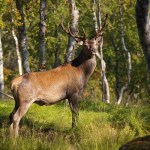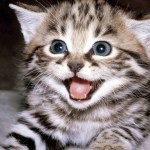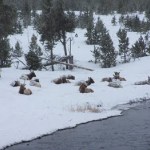deer
I came across a neat article in Scientific American that described how reindeer and elk regrow their antlers every year. Could you imagine putting that much energy into growing new bone each year complete with a velvety cover containing nerves, skin, and blood vessels? Although full-grown antlers lose their blood supply and animals scrape the velvet layer off to reveal just bone.
Researchers have explored whether understanding this amazing process of annual antler regeneration could lead to new therapies to regrow nerves or organs in humans. The nerve fibers that…
Image of a red deer from Wikimedia Commons. Image by: Jörg Hempel
Dr. Walter Arnold (University of Vienna) and colleagues were interested in studying how Northern ungulates cope (physiologically) with limited food supplies during the winter months. Ungulates are known to reduce energy expenditure during the winter. A new study published Wednesday in the American Journal of Physiology-Regulatory, Integrative and Comparative Physiology describes how these animals adjust their nutritional intake. Dr. Arnold's team examined intestinal transport of…
It has long been known by humans that female mammals can be attracted with the call of a young in distress. There is a famous documentary film of the Hadza, a foraging group in Tanzania, in which this method is used by young boys to trap Dasssies (rock Hyrax). First you catch a baby Dassie (not hard) then you hid and bit it in the neck so it cries out, then when the momma Dassies come to rescue it you shoot them at short range with an arrow or whack them with a stick. Adult Efe Pygmy hunters sometimes imitate the call of a young Duiker (a forest antelope) in distress in order to draw in…
Image from: Idaho Nature Notes, http://idahonaturenotes.blogspot.com/2012/01/backyard-deer.html
This was a very good question brought up by a reader of the prior post. As it turns out, deer and elk move between summer and winter ranges. The winter range is at a lower elevation where there are more resources such as shrubs and grasses. Since they eat similar foods, they often compete for resources during the winter when they are more scarce. Since elk are larger and more aggressive, they often win these competitions. According to an article from the University of Idaho, elk are also more…
Prions are proteins that have become bent out of shape. Their chain of amino acids folds up in an abnormal ways, and they can transmit this rogue alignment to their normal counterparts. As their numbers increase, they gather in large clumps that can kill neurons and damage brains. They most famously cause BSE in cows, CJD in humans and scrapie in sheep. But other mammals suffer from prion diseases too - the deer equivalent is called chronic wasting disease or CWD and it is shedding light on how prions are transmitted in the wild.
Gultekin Tamguney from the University of California,…
Farmers and herders have known for centuries that herds of cattle have an uncanny ability to all point in the same direction. Last year, a group of German and Czech scientists discovered the reason behind this alignment - unbeknownst to humans for thousands of years of domestication, these animals have a magnetic sense. The team used Google Earth satellite images to rule out alternative explanations like the wind and the sun, and show that cow and deer herds tend to point towards magnetic north like a living, hoofed compass needle.
Now, the same team have found that high-voltage power lines…
This Roe Deer was born in captivity at the research center of the Center of Natural Sciences just outside of Prato, Italy. With a single horn protruding from the center of its skull, Italian scientists believe that the animal either suffers from a unique genetic mutation or that it is a clear sign of the imminent second coming of Christ.
Special limited edition unicorn votives can be purchased at the Vatican this month only!
Single horned deer are rare, but not unheard of. However it is very unusual for the horn to be in the center of the head. Interestingly the unicorno's twin brother was…
Most of the wildlife photographs I feature here were taken at zoos, but every once in a while I get a chance to photograph some indigenous creatures, White-Tailed Deer (Odocoileus virginianus) being the only relatively large mammal in the area. In fact, New Jersey has an overabundance of the deer, and it's strange to drive late at night and not see at least one along the side of the road (or even trying to cross it). While there were always deer here, they owe much of their population growth in the last 200 years to human development of land, especially the clearing of forests for lawns or…


